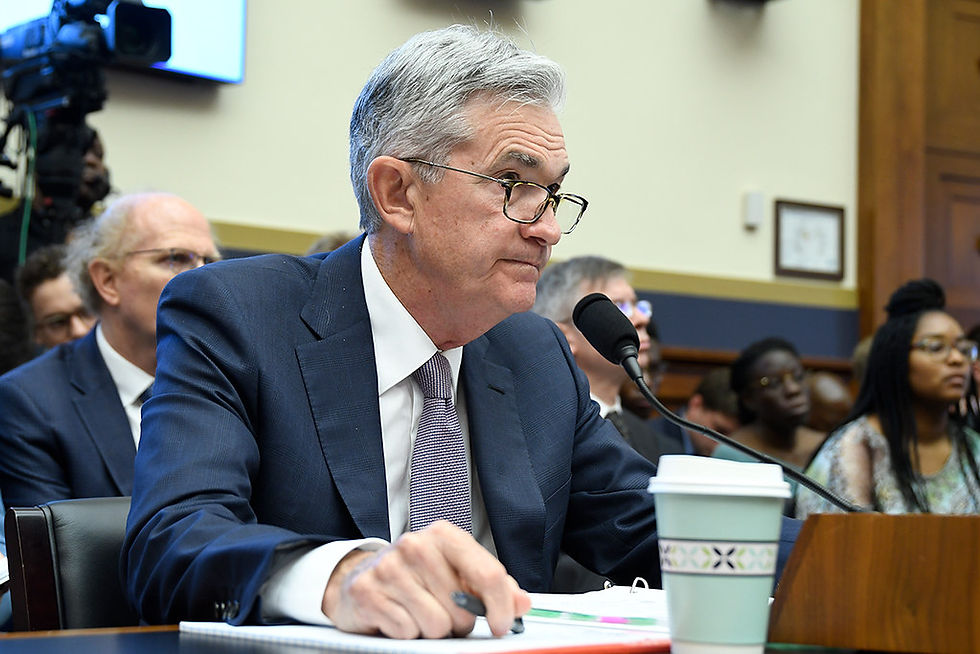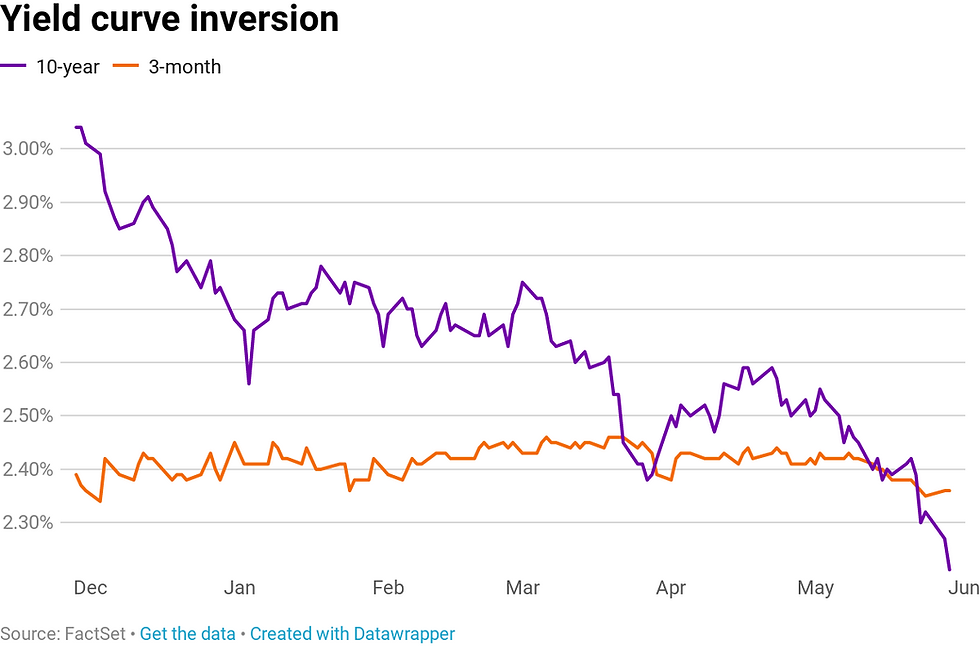The Recession is Coming
- Katharine Sciackitano

- Dec 28, 2019
- 8 min read
Updated: Jul 12, 2023

As of July this year, our current economic expansion has become the longest in recorded American history. Starting in 2009, the U.S. has seen over 10 years of continued economic growth; unfortunately, this trend may not continue much longer. The oft-repeated praises of this so-called booming economy cover up a pessimistic landscape. Aside from the truism that all good things must come to an end, 2019 has brought many indications that another recession is around the corner.
A survey of 226 business economists found that 74 percent of them forecast a recession by 2021, and around 40 percent say it will arrive in 2020. Trends in the U.S. correlate with the global economy; the International Monetary Fund predicts the lowest growth rate in a decade. Although both the I.M.F. and some of Wall Street expect an upturn next year, much of the optimism is from U.S.-China trade talks and the Federal Reserve’s interest rate cuts. Although a recent breakthrough in negotiations improved outlooks, Trump’s trade war could turn poor again at any time. Additionally, the Fed’s intervention shows that its governors are uncertain about the economy—not necessarily optimistic.
Other than just projections, there are many economic indicators that are turning south. Even the growth that we currently have is weak. For months, the Fed’s Federal Open Market Committee has been stating that household spending is rising but “business fixed investment and exports remain weak.” Investment and exports are indeed weak, as multiple quarters in the past few years—including Q2 and Q3 of 2019—have seen negative growth in investment or exports. Government and household spending have driven most of the growth in GDP, but government spending does not mean the private economy is doing well. Household spending also depends somewhat on government transfers or the stimulus of government spending, so the U.S. economy seems to be precariously reliant on Federal money.
The yield curve, which describes the relationship between long and short-term bond yields, recently inverted. The yield of a bond is determined mainly by the demand for it. Higher demand for a bond among investors means the initial price goes up and the profit (the yield) decreases. Normally, investors would demand short-term bonds more than long-term ones, meaning the yield of bonds is low in the short-term and high in the long-term. When investors think the short-term economy will be bad, they demand long-term bonds, driving their yield down and producing the inversion. An inverted yield curve has preceded every recession since 1950, and the last inversion was in 2007 before the Great Recession. While the inversion corrected itself on December 23, it has similarly corrected itself prior to the beginnings of the last three recessions. The fact that it inverted at all is the danger, and the correction has not been a good sign, historically.

This year has also seen large decreases in corporate profits and the manufacturing industry. In fact, manufacturing might already be in a recession. The P.M.I., which measures manufacturing activity, is at its lowest point since 2009. With all of these negative indications, it seems to be only a matter of time before the next recession hits. The question remains: what could set it off?
One event that might catalyze a recession is the repo market. Short for repurchase agreement, repos are a type of overnight loan. A dealer will sell a government security (for example, a Treasury Bond) and agree to buy it back the next day at a higher price. The increase in price is the de facto interest rate. In September of this year, the interest rates of the repo market spiked due to the supply drying up. Banks became unwilling or unable to use excess reserves of cash to buy securities; therefore, there was no one willing to do the first part of a repurchase agreement. The repo market had entered a crisis, which is a huge concern because it underpins the entire financial system.
Although obscure, the repo market is incredibly important. A similar collapse predated the 2007 financial crisis, and it has even been hypothesized that the repo market was a primary factor in the disaster. Since the repo market is the main way for financial institutions to get quick credit, the market drying up could lead to a credit crunch and a debt aversion on Wall Street. A continued crisis in the repo market could lead to banks deleveraging (decreasing their debt), which would lead to mass selloffs of assets as firms try to raise cash to pay down debts. The mass selloffs would, in turn, lead to falling values of both financial asset prices and banks’ stock prices. Deleveraging also means banks would become much more conservative in loaning out money, which slows down the growth of businesses and the real economy. Another hypothesis is that Basel III regulations will incentivize banks to spend big on Treasury securities and draw demand away from stocks, leading to a stock market contraction.
Banks say the market spike in September was due to monetary policy and tight regulations. The Fed poured tons of money into the economy during and after the Great Recession by buying assets from banks, leading cash to flow into the financial system. Now, the Fed has been getting rid of those assets to unwind the crisis-era policies. However, discarding assets also means the Fed must discard liabilities, which include bank reserves. Now banks’ cash reserves are smaller and there is less to go around for the repo market. Banking heads, notably Chase C.E.O. Jamie Dimon, also blame financial regulation for restricting their use of cash reserves. Dodd-Frank and Basel III (post-2008 regulations) rules make banks retain more reserves, so that if another financial crisis occurs they will have more cash on hand to survive. When the money is locked up in reserves, it cannot be released into the repo market. These two systemic factors were exacerbated when, in September, there were corporate tax deadlines and treasury securities being auctioned off. Cash was taken out of the repo market to pay those taxes and to buy treasuries being sold to finance the Federal deficit. This combination of factors caused the September rate spike.
After the repo market spike, the Fed began pouring hundreds of billions of dollars into the repo market, and it plans to dump hundreds of billions more through January to keep the market functioning. Despite these actions, J.P. Morgan predicts another round of problems at the end of this year, when there are more tax deadlines and also regulatory examinations. Basel III rules require examinations of banks at the end of every quarter and year to evaluate their standing as a global systemically important bank (G.S.I.B.), subject to stricter regulations. Most large banks in America are G.S.I.B.s, but there are different levels in the system and being a lower-level G.S.I.B. means fewer restrictions. Banks will likely cut down on their repo transactions during evaluation to increase their cash reserves and hopefully get a lower rating on the G.S.I.B. scale (incidentally, this trend produces skepticism in banks’ claims that regulations have caused the repo market troubles. Banks are hoarding more cash than necessary to game the rules, so should we be blaming the rules who are being abused or the banks who are abusing the rules? This skepticism is especially valid when we consider that these are regulations to prevent another 2007-style economic meltdown and that banks would make much more profit if regulations are rolled back). This disruption could lead to another market spike if the Fed’s dumping doesn’t hold rates down. Already, banks have started to take less of the Fed’s repo money, but it remains unclear if this is due to improvements in the market or the further collapse of it. There is also no guarantee that the systemic forces causing this issue will go away despite the multi-billion dollar injection. Maybe the Fed averts the spike at the end of the year, but what about at the regulatory evaluation at the end of March? Or at the end of June? How long will the Fed continue to dump money into this system? How long can it continue?
A stock market contraction could also spark the recession. The overall market has been overinflated for years now. The 2017 Trump tax cuts led to stock buybacks. Corporations have been buying their own stock to the tune of hundreds of billions, a level never seen before. These buybacks, which used to be illegal stock manipulation, have helped overinflate the prices in the stock market. Such an overvaluation necessitates an eventual market correction and contraction. However, the Fed’s rate cuts and repo funding have also inflated the stock market to levels not seen since before the dot com crash in 2000. Our stock market is now on a dangerous sugar high fueled by buybacks and central bank actions: not the real economy. Such an overvaluation will eventually face correction, a correction that might be disastrous for the stock market. When the stock market fails, shareholders demand executives shore up profits. Executives do this by laying off workers or decreasing wages. These actions boost the bottom line but also damage the economy with more unemployment and less consumer spending.
Whether the repo crisis affects the real economy, the stock market, or just the financial system, a continued repo collapse will likely spill over into a recession. Even if the Fed does save the repo market now, they will have pumped around a trillion dollars into it—this operation is not the sign of a healthy financial system. Our stock market is also set for a huge contraction, maybe a full-blown crash. Even if the stock market and the financial system hold on for a while longer, the underlying real economy is being hollowed out. Any spark in major industries or markets could set off a recession in an economy this weak. Unfortunately, the federal government is in a historically weak position to tackle a recession. The main tools to counter a recession are government spending and Fed policy, but those are already stretched thin. The federal deficit already rivals spending during the Great Recession, and another downturn has not even begun. The Fed’s target interest rate was over 5 percent before the last crash; now, it is below 2. Neither fiscal or monetary policy can be pushed much further, so the basic weapons to fight a downturn will be weak.
The government is not the only entity stretched thin right now. Household debt is at $13.95 trillion, an all-time high. Although at a lower debt-to-G.D.P. ratio than 2008, it is a higher nominal level than the Great Recession era or any era preceding it. Corporate debt has also swelled, growing from $4.95 trillion in 2007 to over $9 trillion today, with an all-time low of cash on hand to deal with said debt. When the recession comes, households and corporations will still need to make payments but with less income. Either loans start to default and the financial system falls lower or more money is taken out of the economy to pay off the debt. In reality, both will probably occur.
All available data points to a recession within 24 months. Indicators are flashing red, crises are building, and households, corporations, and the government are all in weak positions to deal with a recession. Contrary to some pundits’ exclamations, our economy is not doing so well. Despite surface-level quality, the inner workings of our business system forecast a crash, and soon.
Katharine Sciackitano is a first-year C.L.E.G. major in the School of Public Affairs. She is Deputy Editor for Economics at the Agora.
Image courtesy the Federal Reserve, Creative Commons







Comments